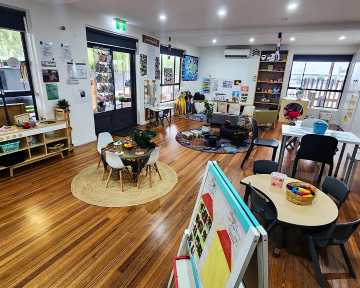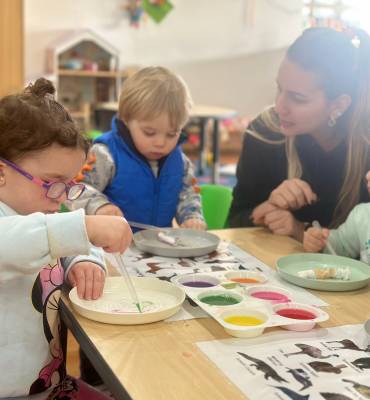MESSY PLAY AT HOME!
When I think about messy play, I can’t help but smile. Whether it’s paint, foam, or slime, my children and I always end up getting covered in something! But that’s part of the fun. Messy play is all about engaging with materials that allow our children to explore the world in a hands-on, sensory way. From sand and mud to jelly and slime, it’s a delightful experience that helps them discover how things feel, look, and even smell. For us, messy play is more than just getting dirty—it’s an opportunity to teach them about their environment and to learn together.
One of the most exciting things about messy play is how it supports children’s development. When my children dive into these experiences, they use their hands, which helps them strengthen their fine motor skills. It’s the perfect way for them to develop both physically and cognitively. I’ve found that talking to them during play is so important—asking open-ended questions helps them think, reason, and understand more about what they’re experiencing. For example, when we play with playdough, I’ll ask, “What shapes can we make with this?” or “How does it feel when you press down on it?” These conversations are key to building their problem-solving and cognitive skills.
The Benefits of Messy Play
The benefits of messy play are endless. Not only does it help children develop motor skills, but it also builds social skills as they interact with others during play. I’ve noticed that my children become more focused and concentrated when they’re engaged in messy experiences, which is so valuable as they work on tasks together.
For us, messy play is a perfect way to introduce math and science concepts too. As my children experiment with different materials, they begin to understand cause and effect. For example, they love making patterns with rice, sand, or coloured paper. Sometimes, they’ll mix materials to see what happens, which is a great hands-on introduction to basic scientific concepts.
I always try to let their curiosity lead the way. Watching them mix objects and materials together has been empowering for them, and it’s a wonderful way to strengthen their decision-making skills. They experiment freely, trying new things and learning from their experiences, which is exactly what I want for them—freedom to explore and learn at their own pace.
Setting Up for Success: Sensory Boxes
One of my favourite ways to keep messy play manageable at home is by creating sensory boxes. These boxes are not only fun, but they also help contain the mess. I’ll fill them with materials like pom-poms, pipe cleaners, large beads, tissue paper, and even foam or slime. Having everything neatly organised in a box makes the cleanup afterward so much easier. Plus, sensory boxes are great for those days when my children are bored with their regular toys, and they need something fresh to spark their imagination.
A good tip I learned the hard way is to always prepare the space before diving into messy play. I usually lay down a plastic mat, tarp, or shower curtain to catch any spills. This way, once we’re done, I can shake out excess sand or glitter outside and keep the house cleaner.
Messy Play in Nature
Sometimes, the best messy play happens outdoors. My children love being outside, and I love watching them connect with nature. We have a small backyard where they can get as messy as they like. I encourage them to make mud pies, build little structures with sticks, or just dig in the dirt. Mud play is a huge favourite for them—it has a squelchy texture that’s both fun and soothing. I’ve even read that playing in the mud can help reduce allergies and asthma, which is a bonus!
Here are a few outdoor messy play ideas we’ve tried (and loved!):
- Toy Dinosaurs in Mud: My children love taking their toy dinosaurs into a mud pit and creating an entire prehistoric world.
- Mud Bakery: Using old pie tins, we create a “mud bakery” and make pretend cakes and cookies.
- Car Wash: We add a little dish soap to the mud and wash toy cars, which has become one of their favourite games.
- Mud Painting: I’ve set up a little outdoor painting station with brushes and paper, and we paint with mud. It’s surprisingly fun and a creative way to engage with the natural world.
Edible Messes for Little Explorers
Since little ones love to explore with their mouths as much as their hands, I’ve found that turning food into a messy play activity works wonders. Here are a few ideas I’ve used to let my children get hands-on with food while also encouraging their creativity:
- Under the Sea: We make a “sea” using blue or green jelly, and my children love playing with toy sea creatures like dolphins, sharks, and turtles.
- Ice Painting: I freeze ice cubes with different food dyes, and they can rub them over paper or the pavement to create colourful designs. On particularly hot days, this is like a mini “Arctic Adventure!”
- Fingers and Yogurt: I mix food dye into plain yogurt, and we let the kids paint with their fingers. It’s edible, so no worries if they taste it!
- Oaty Creations: I fill a tub with oats, and my children create little construction sites or worlds for their toy animals.
- Spaghetti Spaghetti: After cooking spaghetti, we dye it with food colouring and let the kids use it to make colourful, textural art.
One of the great things about messy food play is that it can help children with picky eating habits. Introducing new textures and tastes in a fun, low-pressure way makes it easier for them to be more open to trying new foods.
Messy Play: Making Memories
Acknowledgements:
https://earlychildhood.qld.gov.au/early-years/early-learning-at-home/play/messy-play-ideas
https://playmatters.org.au/blog/messy-play-101-sensory-activities-for-creative-and-curious-children











